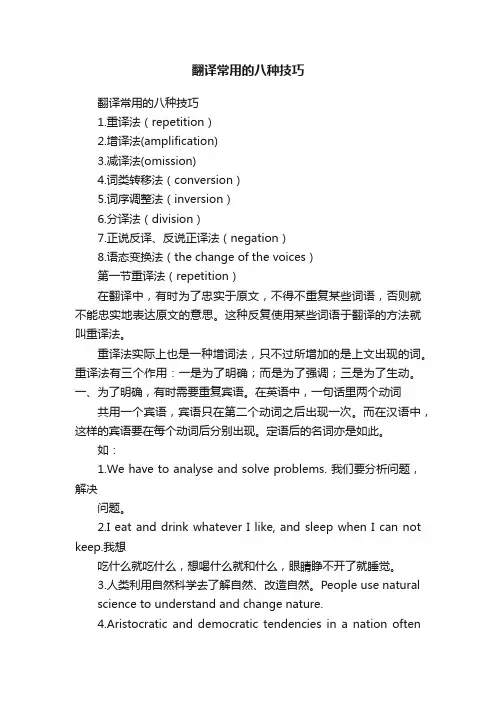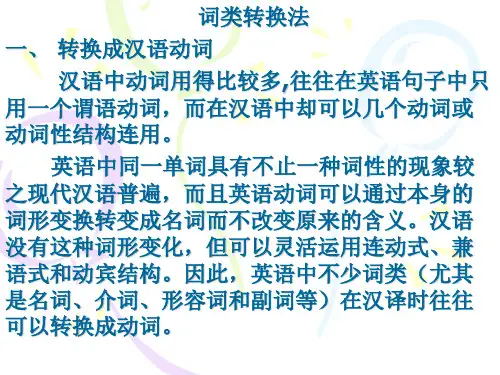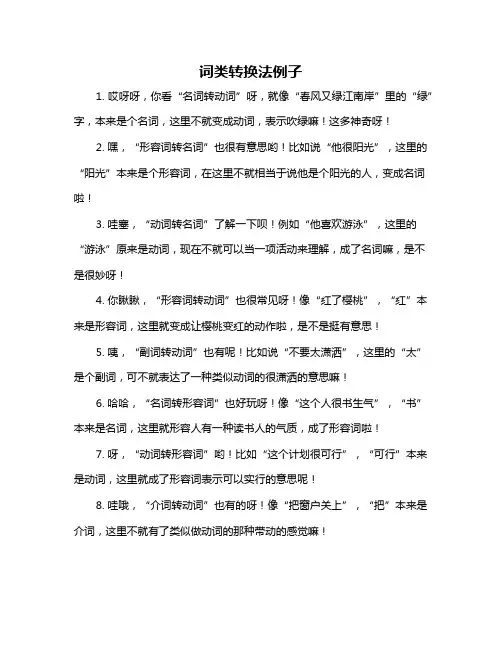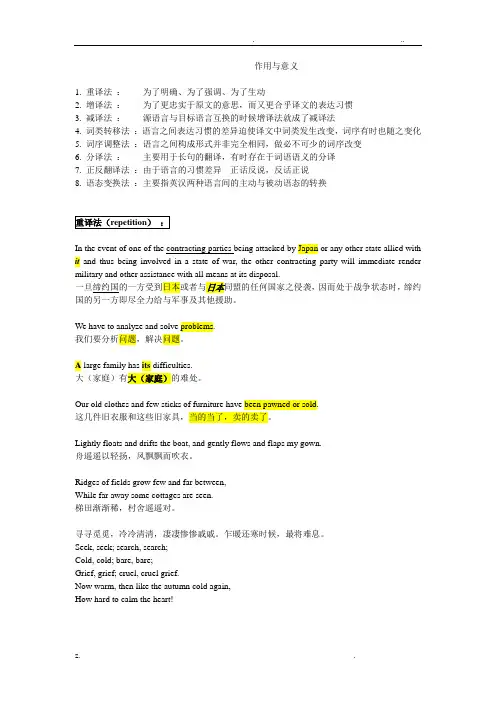词类转移法
翻译常用的八种技巧

翻译常用的八种技巧翻译常用的八种技巧1.重译法(repetition)2.增译法(amplification)3.减译法(omission)4.词类转移法(conversion)5.词序调整法(inversion)6.分译法(division)7.正说反译、反说正译法(negation)8.语态变换法(the change of the voices)第一节重译法(repetition)在翻译中,有时为了忠实于原文,不得不重复某些词语,否则就不能忠实地表达原文的意思。
这种反复使用某些词语于翻译的方法就叫重译法。
重译法实际上也是一种增词法,只不过所增加的是上文出现的词。
重译法有三个作用:一是为了明确;而是为了强调;三是为了生动。
一、为了明确,有时需要重复宾语。
在英语中,一句话里两个动词共用一个宾语,宾语只在第二个动词之后出现一次。
而在汉语中,这样的宾语要在每个动词后分别出现。
定语后的名词亦是如此。
如:1.We have to analyse and solve problems. 我们要分析问题,解决问题。
2.I eat and drink whatever I like, and sleep when I can not keep.我想吃什么就吃什么,想喝什么就和什么,眼睛睁不开了就睡觉。
3.人类利用自然科学去了解自然、改造自然。
People use naturalscience to understand and change nature.4.Aristocratic and democratic tendencies in a nation oftenshowthemselves in its speech.民族的贵族倾向和民族倾向常在其言语中表现出来。
5.我们来修改安全规则和卫生规则吧。
Let’s revise our safety andsanitary regulations.二、英语常用省略,但为了明确,也为了强调某些内容,在汉语中常常要将省去的部分重译出来。
09词类转移

(三)副词转换成名词
英语中有一些以名词为词根派生出的副词,往 往含有“在……方面”、“用……方法”等含 义。翻译时,为了使译文通顺,经常将这类副 词转换为汉语名词。
After careful investigation they found the design behind. 经过仔细研究后,他们发现这个设计落后了
(2) Mr. Nixon had said repeatedly that the American war in Indochina would soon be over.
3.英语中有些副词如above, abroad, around, below, here, there等,常作定 语用,译成汉语时,这类副词往往转换成形容 词,仍然用作定语。
(1) The table below shows the specific weights of metals.
下面的表格中具体列出了金属的比重。
(2) The above suggestion seems to be sensible.
练习题
1.There is much discussion today about whether economic growth is
desirable. (n. →v.)
2. For example, great efforts are made by the American tobacco industry to sell cigarettes in the Middle East and North Africa — where U.S. tobacco exports increased by more than 27%
词类的转移译法 (1)

他们之间的关系,有一个特点,那就是以礼相待。
2.To them, he personified the absolute power.
在他们看来,他就是绝对权威的化身。
黄珍
B 英语被动句式,可译成“受到/遭到---+名词”或“予以/加以--+名词”结构;
她提出的问题表明她是无知的。
B有些名词加不定冠词作表语时,往往转译成形容词
1.The concert is a great success.
音乐会是很成功的。
2.Independent thinking is an absolute necessity in study.
独立思考对学习是绝对必需的。
靖雪玉
有些形容词加定冠词‘the’后表示一类人或 物,这类形容词可称为名词化的形容词。 例如:
1)The social scientist have a keen sense of the new and the old.
社会科学家对新旧事物有敏锐的感觉。
2)They will do their best to build a school for the blind and the deaf.
这类词有: sure,certain,afraid,aware,glad,sorry,confident determined,delighted,ashamed,convinced, concerned, careful, thankful, grateful. 例如:
1)They are quite content with the data obtained from the experiment.
词类转换法例子

词类转换法例子
1. 哎呀呀,你看“名词转动词”呀,就像“春风又绿江南岸”里的“绿”字,本来是个名词,这里不就变成动词,表示吹绿嘛!这多神奇呀!
2. 嘿,“形容词转名词”也很有意思哟!比如说“他很阳光”,这里的“阳光”本来是个形容词,在这里不就相当于说他是个阳光的人,变成名词啦!
3. 哇塞,“动词转名词”了解一下呗!例如“他喜欢游泳”,这里的“游泳”原来是动词,现在不就可以当一项活动来理解,成了名词嘛,是不是很妙呀!
4. 你瞅瞅,“形容词转动词”也很常见呀!像“红了樱桃”,“红”本来是形容词,这里就变成让樱桃变红的动作啦,是不是挺有意思!
5. 咦,“副词转动词”也有呢!比如说“不要太潇洒”,这里的“太”是个副词,可不就表达了一种类似动词的很潇洒的意思嘛!
6. 哈哈,“名词转形容词”也好玩呀!像“这个人很书生气”,“书”本来是名词,这里就形容人有一种读书人的气质,成了形容词啦!
7. 呀,“动词转形容词”哟!比如“这个计划很可行”,“可行”本来是动词,这里就成了形容词表示可以实行的意思呢!
8. 哇哦,“介词转动词”也有的呀!像“把窗户关上”,“把”本来是介词,这里不就有了类似做动词的那种带动的感觉嘛!
9. 嘿嘿,“代词转名词”呀!例如“大家都来了”,“大家”本来是代词,这里就表示所有人,就是个名词啦!总之,词类转换法真的是太神奇啦,能让我们的语言变得丰富多彩呢!。
实用翻译技巧:词类转换法

❖3. 副词---名词 ❖It is officially announced that the
unemployment rate will get lower next year.
官方宣称明年失业率将有所降低。
❖Psychologically and culturally, it is difficult and sometimes threatening to look too closely at failure.
我们仔细研究了这种收入高低即为社 会尺度/标尺的观点。
Hale Waihona Puke ❖2. 名词---副词 ❖I have the honor to inform you that
your application has been accepted.
我荣幸地通知阁下,您的申请已被 接受。
❖四、非形容词转形容词 ❖1. 副词---形容词 ❖Not surprisingly, the rush of
arises because a country’s residents want to buy foreign goods.
外汇需求的产生是因为一个国家的居民 想购买外国商品。
❖The products of our factory are chiefly characterized by their fine workmanship and durability.
❖2. 形容词---动词 ❖These occurrences are normal,
within specifications, and are not indicative of defects in products.
翻译的八大常用技巧

作用与意义1. 重译法:为了明确、为了强调、为了生动2. 增译法:为了更忠实于原文的意思,而又更合乎译文的表达习惯3. 减译法:源语言与目标语言互换的时候增译法就成了减译法4. 词类转移法:语言之间表达习惯的差异迫使译文中词类发生改变,词序有时也随之变化5. 词序调整法:语言之间构成形式并非完全相同,做必不可少的词序改变6. 分译法:主要用于长句的翻译,有时存在于词语语义的分译7. 正反翻译法:由于语言的习惯差异---正话反说,反话正说8. 语态变换法:主要指英汉两种语言间的主动与被动语态的转换In the event of one of the contracting parties being attacked by Japan or any other state allied with it and thus being involved in a state of war, the other contracting party will immediate render military and other assistance with all means at its disposal.一旦缔约国的一方受到日本或者与日本同盟的任何国家之侵袭,因而处于战争状态时,缔约国的另一方即尽全力给与军事及其他援助。
We have to analyze and solve problems.我们要分析问题,解决问题。
A large family has its difficulties.大(家庭)有大(家庭)的难处。
Our old clothes and few sticks of furniture have been pawned or sold.这几件旧衣服和这些旧家具,当的当了,卖的卖了。
Lightly floats and drifts the boat, and gently flows and flaps my gown.舟遥遥以轻扬,风飘飘而吹衣。
II Conversion 转换(4)
e). She escorted the foreign guests around the sights of Haikou. 她陪同外宾游览海口的景点。 f). he is on Hainan Daily. 她在海南日报社任职。 g). The people are with him. 人民拥护他。 h). Millions of the people in the mountainous areas are finally off poverty. 千百万山区人终于摆脱了贫穷。
(B). E. Adjectives into C. Verbs(形—动)
a). He was a frustrated man at that time. 他那时已受挫折。 b). They are news-hungry. 他们迫切想弄到消息。 c). It was a very informative meeting. 会上透露了许多信息。 d). In order to carry through her policies of economic development, peace is necessary for China. 为了贯彻经济发展政策,中国需要和平。
d). They signed two agreements that served to warm up the atmosphere of their relations. 他们签订了两个协定,目的是使他们的关系热乎起 来。 e). A well-dressed man, who looked and talked like an American, got into the car. 一个穿着讲究的人上了车,他的外表和谈吐都像个美 国人。
a). Concern for the preservation of public property should not be confined to protecting it from thieves and wreckers. 关注保护公共财产不应仅限于使其免遭偷盗与破坏。 b). This shop has a large choice of hats and shoes. 这家商店有多种款式的鞋帽可供选择。 c). The cathedral is a conglomeration/combination of contrary styles and periods. 这座大教堂综合了不同时期的不同建筑风格。 d). Every state is the best judge of what is required to safeguard its national security. 每个国家最清楚应怎样维护自己的国家安全。 e). We are enemies of all aggressive wars. 我们反对一切侵略战争。
翻译常用的八种技巧
翻译常用的八种技巧1.增译法、增词法:amplification2.重译法、重复法:repetition3.省译法、减词法:omission4.词性转换法、词类转移法:conversion5.正说反译、反说正译法:negation6.语态变换法:the change of the voices7.分译法、分句法(OPP:合句法):division8.语序调整法、词序调整法(顺序法与逆序法)inversion增词法译文中添加一些原文没有的词句,表面上看似不忠实于原文,但仔细分析就会发现这些增加的词句所表达的意思并非无中生有,而是隐含在原文中的。
要知道,从一种语言文字向另一种语言文字转换,有时可以找到一种语言文字在另一种语言文字中的对等词,然而要想全部依赖对等词的转换来达到翻译的目的是几乎不可能的。
不同语言文字所持有的习惯决定了必须根据其中一种语言文字的习惯来适当地增词(或减词)达到语言交际的目的。
如果机械地按照字面意义直译,不仅不能表达原文的思想,精神与形象,而且还会使译文前后矛盾,闹出笑话。
例1 听到你平安的消息,非常高兴!译文: I was very glad on hearing that you were in safety!例2对不起,打扰一下!译文: Excuse me for interrupting you!(增补作宾语的代词you)例3 Histories make men wise; poems witty; the mathematics subtle; natural philosophy deep; moral grave; logic and rhetoric able to contend.译文:读史使人明智,读诗使人灵秀,数学使人周密,科学使人深刻,伦理使人庄重,逻辑修辞之学使人善辩。
(译文中添补了谓语和宾语:增词法;重译法)例4:We won’t retreat, we never have and never will.译文:我们不后退,我们从来没有后退过,我们将来也绝不后退。
英汉翻译中的词类转换技巧
英汉翻译中的词类转换技巧第一篇:英汉翻译中的词类转换技巧英汉翻译中的词类转换技巧翻译考试中英语汉翻译中的词类转换技巧:由于汉语国家和英语国家在历史、文化、风俗习惯等各方面的不同,在语言上形成了很大差异。
有时候一句英文在英美人看来顺理成章,但在中国人看来却是颠三倒四,极为别扭。
很多时候,需要我们对语言中的词类进行转换,然后再翻译,方可使译文显得通顺、自然。
一般来说,词类转译技巧的运用可从以下四个方面加以注意。
1、转译成动词英语中的某些名词、介词、副词,翻译时可转译成汉语中的动词。
The lack of any special excretory system is explained in a similar way.植物没有专门的排泄系统,可用同样的方式加以说明。
(名词转译)As he ran out, he forgot to have his shoes on.他跑出去时,忘记了穿鞋子。
2、转译成名词英语中的某些动词、形容词,翻译时可转换成汉语中的名词。
The earth on which we live is shaped a ball.我们居住的地球,形状象一个大球。
(动词转译)The doctor did his best to cure the sick and the wounded.医生尽了最大的努力来治疗病号和伤员。
(形容词转译)3、转译成形容词英语中有些作表语或宾语的抽象名词,以及某些形容词派生的名词,往往可转译成汉语中的形容词。
另外,当英语动词转译成汉语名词时,原来修饰该动词的副词也往往随之转译成汉语中的形容词。
It is no use employing radar to detect objects in water.使用雷达探测水下目标是没有用的。
(作表语的名词转译)The sun affects tremendously both the mind and body of a man.太阳对人的身体和精神都有极大的影响。
词类转移法—conversion
Why conversion is necessary in translating work?
词类转译法是翻译中使用非常普遍的一种技 巧。由于英汉两种语言表达方式和习惯的丌 同 ,丌能在所有的情况下都用“一个萝卜一 个坑”的方法来逐词对译。在翻译过程中要想 做到既忠实原文意思,又符合汉语的表达习惯, 有些句子就丌能逐字翻译,而需要改变某些词 的原来的词性,才能使译文通顺流畅。
译法1:他同邦迪谈了一会,他提出的问题反映出他怀疑 的巨大性。 译法2:他同邦迪谈了一会,他提出的问题反映出他很大 的怀疑。
2.As he is a perfected stranger in the city, I hope you will give him the necessary help.
译法1:他是这个城市完全的陌生人,所以我希望你给他 必要的帮助 译法2:他对这座城市完全陌生,所以我希望你给他必要 的帮助
What is
conversion?
The act or process of changing something from one form , purpose or system to a different one.
.
爆笑的填坑式翻译
1、how are you ? How old are you? 怎么是你,怎么老是你。 2、you me you me 彼此彼此
3、you give me stop 你给我站住
4、dragon born dragon, chicken born chicken,mouse’s son can make hole! 龙生龙,凤生凤,老鼠的儿子会打洞。
4.The two bodies are so far apart that the attractive force between is negligible. 这两个物体相聚如此之远,他们之间的引力 可以忽略不计。 5.The work at the weather observation stations goes on regularly without any interruption, in spite of any weather conditions. 不管天气情况如何,气象站的工作始终正常 进行,不曾间断。 6.This credit card is especially popular with the travellers who needn't carry a large amount of cash. 旅游者特别喜欢这种信用卡,因为他们不用 携带大量现金
